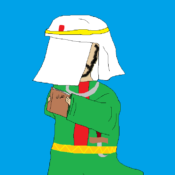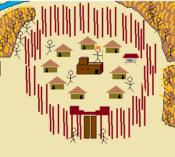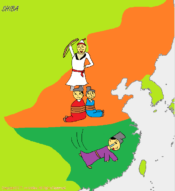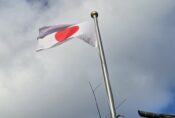8世紀~フランク、大仏、アラビアンナイト~ Frank, the Great Buddha, Arabian Nights

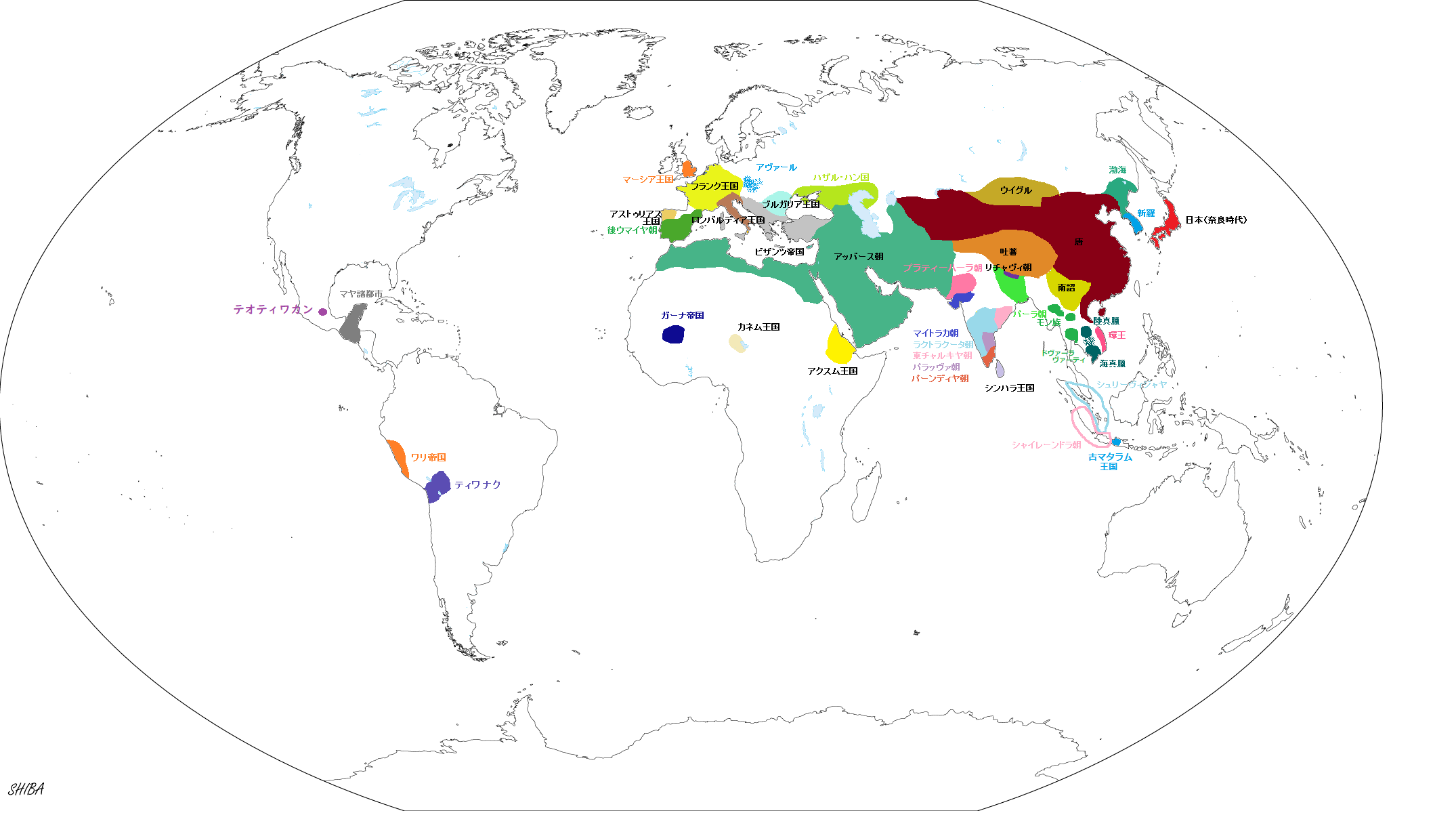
前(7世紀~イスラムの誕生と唐の繁栄~) ← → 次(9世紀~海賊の栄光・イスラムの伝道~)
7世紀に誕生したイスラム教は、8世紀になると更にアラビアの周辺(中央アジア、スペイン)へと広まっていきます。ただこの頃には征服活動だけではなく交易による広まりも重要となっていきます。長い混乱が続いたヨーロッパはようやく統一の兆しを見せ始めますが、中国(唐)では逆に8世紀半ばから不安定期に入ってしまいます。
The Islamic faith, which emerged in the 7th century, spread further in the 8th century to regions surrounding Arabia, such as Central Asia and Spain. During this period, not only military conquests but also the expansion through trade became increasingly important. While Europe, after a long period of turmoil, began to show signs of unification, China (Tang dynasty), on the other hand, entered a period of instability from the mid-8th century onward
もくじ
日本 Japan
日本では持統天皇下の701年、国内初の本格的な法令文書、「大宝律令」が完成し、大和朝廷を中心とした政府が成立します。この文書作成に活躍したのが藤原不比等。彼は藤原鎌足の息子で、この親子2代にわたる活躍により、藤原氏は力をつけていきました。
In Japan, under Empress Jitō(持統天皇), the nation’s first full-fledged legal code, the Taihō Code(大宝律令), was completed in 701, establishing a government centered on the Yamato(大和) court. Fujiwara no Fuhito(藤原不比等), the son of Fujiwara no Kamatari(藤原鎌足), played a major role in drafting this document. Through the achievements of this father and son over two generations, the Fujiwara clan gradually gained power.
710年平城京に都が遷され、奈良時代が始まります。しかし疫病や飢饉が連続したことから、人々は仏教に救いを求めるようになりました。当時国を治めていた 聖武天皇が僧侶の行基らに命じて大仏を建立し、唐から高僧の鑑真を招いたのは8世紀半ばのことです。しかしこの結果、平城京では僧侶の力がつきすぎて、政治を左右するまでになりました。
In 710, the capital was moved to Heijō-kyō (平城京Nara at present), marking the beginning of the Nara period(奈良時代). However, repeated outbreaks of epidemics and famines led people to seek salvation in Buddhism. In the mid-8th century, Emperor Shōmu(聖武天皇), who ruled at the time, ordered the monk Gyōki(行基) and others to construct the Great Buddha and invited the eminent Chinese monk Ganjin(鑑真) to Japan. As a result, the influence of Buddhist monks in Heijō-kyō grew so strong that it began to affect politics.
781年即位した桓武天皇は794年に平安京を築いて、再度都を移しました。当初の平安京には最低限の寺院しか無かったといいます。
Emperor Kanmu(桓武天皇), who ascended the throne in 781, built Heian-kyō (平安京 Kyoto at present) in 794 and moved the capital once again. It is said that, at first, Heian-kyō had only the minimum number of temples.
奈良時代には、日本最古の歴史書である『古事記』『日本書紀』がまとめられ、また古今東西の和歌を集めた『万葉集』も作られました。奈良の大仏を祀った東大寺、鑑真のために建立された唐招提寺、聖武天皇の遺品を保存した正倉院などの建築物も有名です。一連の文化を天平文化と呼びます。
During the Nara period, Japan’s oldest historical records, the “Kojiki(古事記)” and “Nihon Shoki(日本書紀)”, were compiled, and the “Man’yōshū(万葉集)”, a collection of Japanese poems from various eras, was also created. Famous buildings from this period include Tōdai-ji(東大寺), which houses the Great Buddha; Tōshōdai-ji(唐招提寺), built for Ganjin; and the Shōsōin(正倉院), which preserves the relics of Emperor Shōmu. This series of cultural achievements is referred to as Tenpyō culture(天平文化).
東アジア East Asia
中国は唐の時代のど真ん中でした。8世紀初頭には中国史上唯一と呼ばれる女帝、則天武后が権力を奮いました。彼女の治世には、隋の時代に始まった官僚試験科挙が定着しました。これは何度か中断や変革を経ながら、清の時代まで続きます。
China was in the midst of the Tang(唐) dynasty at this time. In the early 8th century, Wu Zetian(武则天), the only female emperor in Chinese history, wielded great power. During her reign, the imperial examination system known as the keju(科挙), which had begun in the Sui (隋)dynasty, became firmly established; this system, though it underwent interruptions and reforms, continued until the Qing(清) dynasty.
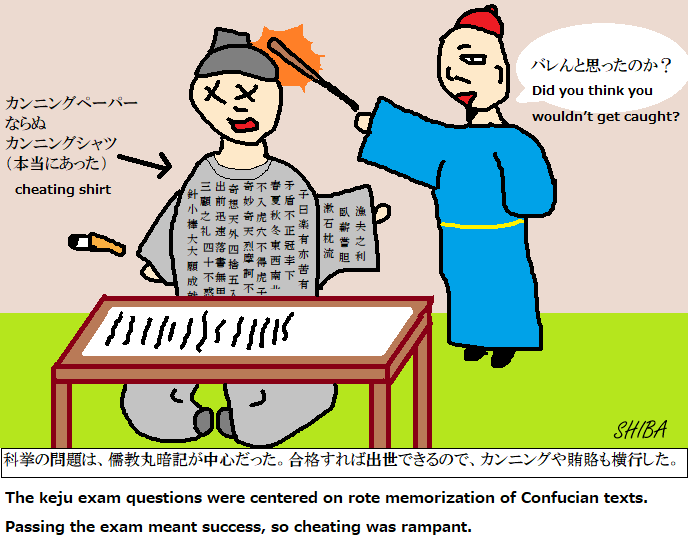
8世紀前半~半ばは、6代目皇帝玄宗の長い治世が続き、唐の繁栄が続きました。彼は広大な唐の各地に節度使という役人を派遣し、監視に当たらせました。軍事面では、農民に徴兵の義務を与える府兵制から、傭兵を募集する募兵制へと転換され、農民の負担は改善されました。
From the early to mid-8th century, the sixth emperor, Xuanzong(玄宗), enjoyed a long reign, during which the Tang dynasty continued to flourish. He dispatched officials called jiedushi (节度使:regional military governors) to various parts of the vast empire to oversee and supervise local affairs. In military matters, the system shifted from the fubing(府兵) system, which required conscription of peasants, to the mubing(募兵) system, which recruited mercenary soldiers, thereby alleviating the burden on the peasantry.
有能な官僚も玄宗を支えましたが、その中には日本からやってきた 阿倍仲麻呂の姿もありました。このような玄宗の時代は、当時の元号を採って、「改元の治」と呼ばれます。 文化面も華やかで、李白、杜甫といった、中国史上最高の詩人が登場するのもこの時代です。
Xuanzong was also supported by talented bureaucrats, among whom was Abe no Nakamaro(阿倍仲麻呂), who had come from Japan. This era under Xuanzong is known as the “Kaiyuan Reign(开元盛世),” named after the era name, and is celebrated for its prosperity. Culturally, it was a dazzling period, with the emergence of some of the greatest poets in Chinese history, such as Li Bai(李白) and Du Fu(杜甫).
しかし晩年の玄宗は美女楊貴妃に溺れ、政治への興味を失います。中央では楊貴妃の一族(楊氏)が好き勝手に振る舞ったっため、不満を持った節度使の安禄山、史思明らが反乱を起こしました。安史の乱です。この大乱を機に唐は曲がり角を迎えます。
However, in his later years, Emperor Xuanzong became infatuated with the beautiful consort Yang Guifei(杨贵妃) and lost interest in governing. At the center of power, Yang Guifei’s family (the Yang clan) behaved as they pleased, which led to discontent among regional military governors such as An Lushan(安祿山) and his subordinate Shi Siming(史思明), who eventually launched a rebellion. This was the An Lushan Rebellion(安史之亂). Driven from the capital Chang’an(长安) by this great upheaval, Xuanzong was forced to order Yang Guifei’s execution and ultimately abdicated the throne himself. This marked a turning point for the Tang dynasty.
朝鮮半島の新羅でも文化面で最盛期を迎え、8世紀半ばの景徳王の時代、朝鮮半島最大の仏教寺院、仏国寺の建立が開始されました。一方で、新羅には骨品制という厳格な身分制度が存在し、王位継承者はもちろん、官僚の地位や結婚相手にまで様々な規制が設けられていました。
Meanwhile, on the Korean Peninsula, Silla(신라/新羅) reached its cultural peak, and during the reign of King Gyeongdeok(경덕왕/景德王) in the mid-8th century, construction began on Bulguksa(불국사/佛國寺), the peninsula’s largest Buddhist temple. On the other hand, Silla had a strict social hierarchy known as the bone rank system(골품제도/骨品制度), which imposed various restrictions not only on royal succession but also on bureaucratic positions and even marriage partners.
朝鮮半島北部では、高句麗の生き残り大祚栄が、渤海という国を建設。日本とも友好関係を築きました。
To the north, King Go/Dae Joyeong(고왕/대조영:高王/大祚榮), a survivor of Goguryeo(고구려/高句麗), founded the kingdom of Balhae(발해/渤海), which also established friendly relations with Japan.
チベットの吐蕃は、シルクロードなど西域方面の交易路をめぐって唐と争っていました。755年安史の乱で唐に動揺が走ると、当時の吐蕃王ティソン・ディツェンはこれに乗じて敦煌などを一時占領し、シルクロード交易において、優位に立ちます。このシルクロードを越えて大きく広まったのが仏教でした。ティソン・ディツェンも仏教を吐蕃の国教と定め、チベット仏教はここから独自の進化を遂げていくことになります。
In Tibet, there were ongoing conflicts with the Tang dynasty over control of trade routes in the Western Regions, such as the Silk Road. When the An Lushan Rebellion shook the Tang in 755, the Tibetan king at the time, Trisong Detsen, took advantage of the situation to temporarily occupy Dunhuang(敦煌) and other areas, expanding his territory. This allowed Tibet to gain an advantageous position in Silk Road trade. Buddhism was one of the major influences that spread widely along the Silk Road. Trisong Detsen also established Buddhism as the state religion of Tibet, and from this point, Tibetan Buddhism began to develop its own unique characteristics.
同じくチベット系の王族が現在の中国雲南省周辺に建てたのが、南詔国です。8世紀半ばにこの国は唐からも吐蕃からも自立し、唐支配下のベトナムなどにも侵攻しています。
Similarly, a Tibetan royal lineage established the Kingdom of Nanzhao(南诏) around present-day Yunnan(云南) Province in China. By the mid-8th century, Nanzhao had become independent from both the Tang and Tibet, and even launched invasions into Tang-controlled Vietnam.
南アジア South Asia
この時代のインドは混沌としていたようです。それまでガンジス川流域に築かれていたインド文化やインド社会が、周囲の乾燥した地域や遊牧民社会にも根を下ろし、新たな王朝が生まれていったからです。
It appears that India during this period was in a state of chaos. This was because Indian culture and society, which had developed along the Ganges River, began to take root in the surrounding arid regions and among nomadic societies, giving rise to new dynasties.
インド北部では遊牧民グルジャラ人によって8世紀半ば築かれたプラティハーラ朝が拡大していきました。インド東部のベンガル地方には、パーラ朝が成立。この王朝は仏教を重んじたインド最後の国となります。インド南部のデカン高原では、752年チャールキヤ朝を破ったラシュトラクータ朝が拡大。この3王朝が三つ巴の勢力争いを繰り広げていきました。
In northern India, the Pratihara dynasty, founded by the nomadic Gurjara people in the mid-8th century, expanded its influence. In the Bengal region of eastern India, the Pala dynasty was established, becoming the last Indian dynasty to strongly support Buddhism. In southern India, on the Deccan Plateau, the Rashtrakuta dynasty, which had defeated the Chalukya dynasty in 752, expanded its power. These three dynasties engaged in a three-way struggle for supremacy.
東南アジア South East Asia
インドシナ半島では、カンボジアにあった国真臘が拡大していきました。以前この地に存在していた扶南と同様、次第に中国やインドとの経済的な結びつきを強め、そこから富を得て繁栄していきます。ただ、カンボジアと中国(唐)を結ぶ交易ルートは複数存在していました。主要なものが、内陸部の湖や川を用いたルートと、南シナ海へ出るルートの2つで、結果的に真臘はそれぞれを重んじる勢力に分裂していきます。前者は陸真臘、後者は水真臘と呼ばれ、おのおの競うように大国へ自らを売り込んでいきました。こうした中、陸・水の両ルートどちらにも携わる事ができた地域が次第に大きくなっていきます。それこそがアンコール地方でした。
In the Indochina Peninsula, the state of Chenla in Cambodia expanded its territory. Like the earlier kingdom of Funan in the same region, Chenla gradually strengthened its economic ties with China and India, gaining wealth and prosperity through these connections. However, there were multiple trade routes linking Cambodia and China (the Tang dynasty). The main ones were an inland route utilizing lakes and rivers, and a route leading out to the South China Sea. As a result, Chenla eventually split into factions that prioritized each route. The group favoring the inland route was called Land Chenla, while the group favoring the maritime route was called Water Chenla, and each competed to promote themselves to the major powers. Amidst this situation, the region that was able to control both the land and water routes gradually grew in importance-this was the Angkor area.
インドネシアのジャワ島にも、この頃強力な王家が出現します。ひとつが、8世紀初頭に即位したサンジャヤ王を祖とするサンジャヤ王家で、ジャワ中央部のマタラム(現ジョグジャカルタ)に都をおいたことから、古マタラム王国と呼ばれます(「古」と付いているのは、後の時代に登場するマタラム・スルタン国というイスラム系の王朝と区別するため)。初期の王国については不明点も多いのですが、ヒンドゥー教を信仰していたとされます。
On Java in Indonesia, powerful royal families also emerged around this time. One was the Sanjaya dynasty, founded by King Sanjaya who ascended the throne in the early 8th century. With its capital at Mataram in central Java (present-day Yogyakarta), it is known as the Old Mataram Kingdom (the term “Old” distinguishes it from the later Islamic Mataram Sultanate). Much about the early kingdom remains unclear, but it is believed to have followed Hinduism.
もう一つが8世紀半ばに古マタラム王国を支配下に置いたシャイレーンドラ王家の王国、シャイレーンドラ朝です。この王朝は仏教を重んじており、各地に寺院を建立していきます。8世紀後半には、マラッカ海峡の両岸に栄えたシュリーヴィジャヤ(室利仏逝)をも征服し、東南アジア海域に大きな勢力を張りました。
Another was the Sailendra dynasty, which brought the Old Mataram Kingdom under its control in the mid-8th century. The Sailendra dynasty revered Buddhism and built temples throughout the region. In the late 8th century, it even conquered Srivijaya, which flourished on both sides of the Strait of Malacca, and established a major presence in the maritime regions of Southeast Asia.
西アジア・中央アジア West Asia /Central Asia
イスラム教は、ウマイヤ朝の元でも周囲へ広まっていきます。東は中央アジアからシルクロードを経て、現在のキルギス付近まで及びました。同じ時代、東から影響力を拡大していたのが中国の唐でした。こうして唐とイスラムの軍は751年に激突。タラス河畔の戦いです。この戦いで捕虜となった中国人により製紙法が中東へ伝わったとされています。
Under the Umayyad Caliphate, Islam continued to spread to surrounding regions. To the east, it reached as far as present-day Kyrgyzstan via Central Asia and the Silk Road. During the same period, the Tang dynasty of China was also expanding its influence from the east. In 751, the armies of the Tang and the Islamic world clashed at the Battle of Talas. It is said that Chinese prisoners captured in this battle brought papermaking technology to the Middle East.
西方へは北アフリカモロッコまでを征服した後、ジブラルタル海峡を越え、遂にはイベリア半島(現スペイン・ポルトガル)の西ゴート王国を711年滅ぼしました。しかしウマイヤ朝は自分たち(アラブ人)をえこひいきし、ペルシャ人など元々住んでいた人々(マワーリーと呼ばれました)を差別する社会でした。そのため支配域の拡大とともにマワーリーの人口もその不満も増大。750年、マワーリーの支援を受けたアッバース家がウマイヤ家を打倒します。
To the west, after conquering North Africa all the way to Morocco, the Umayyads crossed the Strait of Gibraltar and came to rule the Iberian Peninsula destroying Visigothic Kingdom in 711. However, the Umayyad dynasty showed favoritism towards themselves (the Arabs) and created a society that discriminated against the original inhabitants such as the Persians, who were known as “Mawali” (non-Arab converts to Islam). As the empire expanded, the Mawali population and their discontent grew. In 750, with the support of the Mawali, the Abbasid family overthrew the Umayyads.
アッバース朝の2代目カリフマンスールは、シルクロードへつながる交易路とティグリス川の両方を利用できる地に新王都を建設。これが現在のイラクの首都でもあるバグダッドです。以後バグダッドは、イスラムの政治経済の中心となりました。
The second Abbasid Caliph Mansur built a new capital in a location that allowed access to both the Silk Road trade routes and the Tigris River-this was Baghdad, which is now the capital of Iraq. From then on, Baghdad became the political and economic center of the Islamic world.
8世紀末に登場した第5代カリフ、ハールーン・アッラシードはアラブ・非アラブの区別なく、優れた官僚や学者を採用し、アッバース朝はこの時期黄金期を迎えました。後の時代に作られた『アラビアンナイト』には当時の華やかな社会が描かれており、中にはハールーン・アッラシードが登場するエピソードもあります。
Harun al-Rashid, the fifth Caliph who emerged in the late 8th century, employed talented bureaucrats and scholars regardless of Arab or non-Arab descent, leading the Abbasid Caliphate to its golden age during this period. The Arabian Nights, compiled in later centuries, depicts the vibrant society of that era, with some episodes featuring Harun al-Rashid himself.
しかし、バグダッドから遠く離れた地ではすでに王朝から自立する動きが出てきました。750年にアッバース朝が成立すると、滅ぼされたウマイヤ家の生き残り、アブド・アッラフマーンがイベリア半島にまで逃げ、756年現スペイン南部の都市コルドバを中心としたウマイヤ朝を再建しました。一般には「 後ウマイヤ朝」あるいは、「コルドバのウマイヤ朝」と呼ばれます。
However, in regions far from Baghdad, movements for independence from the central government began to emerge. After the Abbasids came to power in 750, Abd al-Rahman, a surviving member of the Umayyad family, fled to the Iberian Peninsula and in 756 established a new Umayyad dynasty centered in Córdoba, in what is now southern Spain. This is generally known as the “Later Umayyad Caliphate” or the “Umayyad Caliphate of Córdoba.”
同じくバグダッドから離れたモロッコには、776年メッカで反乱に失敗したイドリースなる人物が逃げてきます。彼はアッバース朝のスンニ派に対抗して789年イバード派という宗派の王朝を建てました。イドリース朝といいます。同じく現在のアルジェリアの一部にもイバード派のルスタム朝が成立しました。
Similarly, in Morocco, Idris, who had failed in a rebellion in Mecca in 776, fled and established the Idrisid dynasty in 789, which followed the Ibadi sect in opposition to the Sunni Abbasids. In present-day Algeria, the Ibadi Rustamid dynasty was also established.
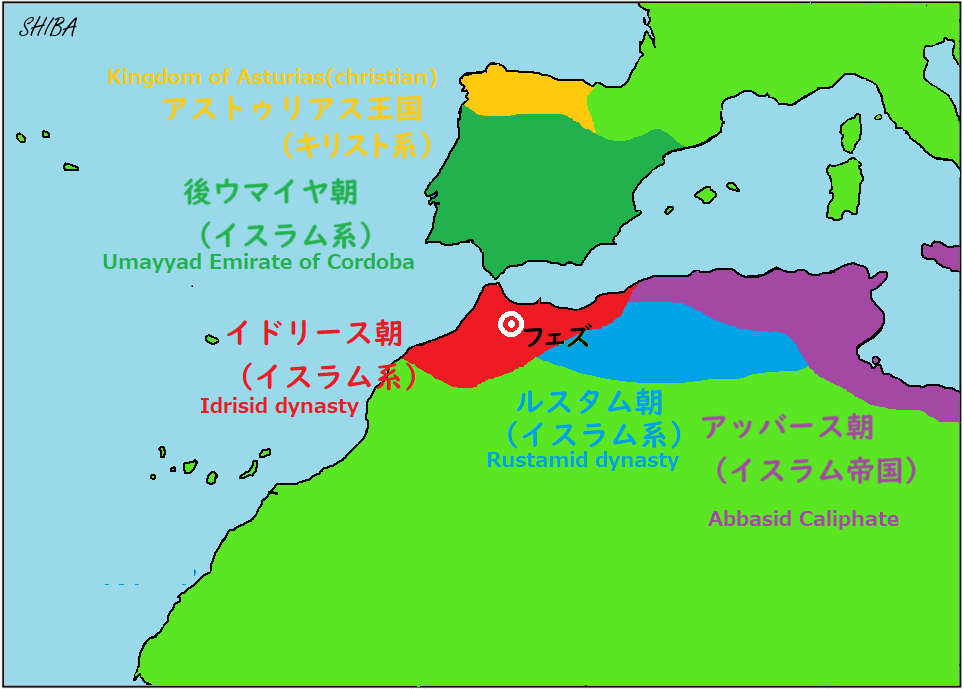
↑世界史に(あまり)出てこない国の歩み~モロッコの歴史~より
東ヨーロッパ
拡大を続けるイスラムに対し、ビザンツ帝国は何度も存亡の危機に立たされました。しかし首都コンスタンティノープルの巨大な城壁と、「ギリシャの火」と呼ばれる秘密兵器がイスラム軍の侵入を防ぎ、8世紀前半レオン3世の時代までにはこの危機を脱します。
As the expansion of Islam continued, the Byzantine Empire repeatedly faced existential threats. However, the massive walls of the capital, Constantinople, along with the secret weapon known as “Greek fire,” prevented the Muslim armies from invading, and by the reign of Leo III in the early 8th century, the empire had overcome this crisis.
このレオン3世ですが、イスラムの偶像崇拝(神様の像を拝むこと)禁止に影響されたためか、はたまた西ヨーロッパのカトリック教会に対抗するためか、キリスト教を広めるのに使われていたイコンを批判し、これを禁止します。
As for Leo III, perhaps influenced by Islam’s prohibition of idolatry (the worship of images of deities), or perhaps in opposition to the Catholic Church in Western Europe, he criticized the use of “icons,” which had been used to spread Christianity, and went so far as to ban them.
イコンとは、イエス・キリストや聖母マリアを描いた絵のことで、字が読めない、聖書のラテン語がわからない人々にキリストを布教するのに大いに役立っていました。しかし本来のキリスト教も、ユダヤ教もイスラム教も偶像崇拝は禁止されており、レオン3世は、イコンの使用もこれに当てはまるとしたのでした。
Icons, which depicted Jesus Christ or the Virgin Mary, were invaluable for spreading the faith among people who could not read or understand Latin scripture. However, since Christianity, like Judaism and Islam, originally forbade idolatry, Leo III considered the use of icons to fall under this prohibition too.
彼を継いだビザンツ皇帝コンスタンティノス5世は更にイコンや聖像の徹底的な破壊を命じ、特にこれらを多く用いていた修道士を多数弾圧しました。ビザンツ帝国下のギリシャでは、この結果、古代から続いていた石像、絵画を作る技術が大きく衰退してしまったといいます。このような乱暴なやり方は、帝国の内外でも評判が悪く、この皇帝は後世「ウ〇コ帝」というヒドイあだ名を貰ってしまいました。
His successor, Emperor Constantine V, intensified the destruction of icons and religious images, and especially persecuted monks, who were major supporters of icon veneration. As a result, the traditional skills of creating statues and paintings that had continued since ancient times in Greece under Byzantine rule declined significantly. Such harsh measures were widely criticized both inside and outside the empire, and this emperor was later given the derisive nickname “the Dung Emperor” by posterity.
西ヨーロッパ West Europe
暗黒時代の続いたヨーロッパにも大きな変化が起きます。イベリア半島を征服したウマイヤ朝の軍は、更にピレネー山脈を越え、現在のフランス南部にまで進出しました。ここに立ちはだかったのがフランク王国。その宰相カール・マルテルは、トゥール・ポワティエ間の戦いでイスラム軍を破り、ローマ教皇の信頼を得ました。
Significant changes also occurred in Europe, which had long been in a dark age. The Umayyad forces that conquered the Iberian Peninsula advanced further, crossing the Pyrenees and reaching what is now southern France. Standing in their way was the Frankish Kingdom. The Frankish mayor of the palace, Charles Martel, defeated the Islamic army at the Battle of Tours and Poitiers, earning the trust of the Pope.
フランク王国はキリスト教の拡大にも努め、ローマ教皇との関係も強化されました。カール・マルテルの子ピピンは、751年に王位をメロヴィング家から奪い、カロリング朝が始まります。その際、ローマ教皇に奪ったイタリア北部の一部(ラヴェンナ地方)をプレゼント(ピピンの寄進)これによって彼はローマ教皇から王位を認められました。
The Frankish Kingdom also promoted the spread of Christianity and strengthened its relationship with the papacy. Charles Martel’s son, Pepin, seized the throne from the Merovingians in 751, founding the Carolingian dynasty. At that time, he presented part of northern Italy (the region of Ravenna), which he had taken, to the Pope-an act known as the Donation of Pepin. In return, the Pope recognized Pepin’s kingship.
その息子カール1世(大帝)は、その生涯の多くを戦いに費やし、774年に北イタリアのランゴバルド王国を征服、北方ではドイツ北部にいたゲルマン系のザクセン人を降伏させました。イベリア半島では後ウマイヤ朝にも侵攻しましたが、これには敗北。この時のエピソードは後の時代、抒情詩『ローランの歌』となって人々の間に語り継がれることとなります。しかしそれでも地中海に面する都市バルセロナは、フランク王国の元に入りました。
Pepin’s son, Charles I (Charlemagne), spent much of his life in military campaigns, conquering the Lombard Kingdom of northern Italy in 774 and subduing the Saxons, a Germanic people in northern Germany. He also launched invasions against the Umayyads in the Iberian Peninsula, but was defeated; this episode was later immortalized in the epic poem “The Song of Roland.” Nevertheless, the Mediterranean city of Barcelona came under Frankish control.
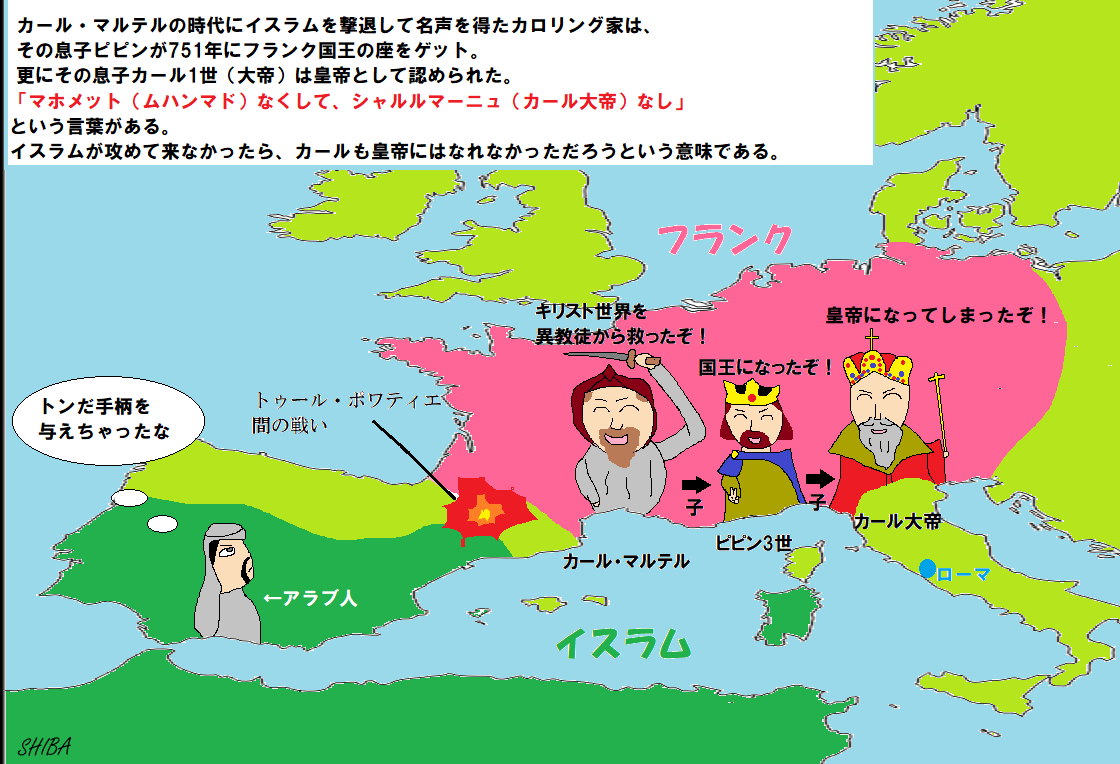
一連の活躍が認められ、カール1世は800年のクリスマスの日、教皇レオ3世から「ローマ皇帝の後継者」として、王冠を受けました。このカール戴冠がきっかけで、ヨーロッパの重心が南から西へと移っていきます。
In recognition of his achievements, Charles I was crowned “Emperor of the Romans” by Pope Leo III on Christmas Day in the year 800. This coronation marked a shift in the center of gravity of Europe from southern to western Europe.
様々な民族が争う不安定な時代、自分の土地を守りたいと思った一般の人々は、地元の貴族など軍隊を持つような有力者に土地を差し出し、保護を頼みました。有力者(主君)は土地を受け取ったうえで、改めて本来の持ち主(家臣)に貸出す契約をし、今まで通りに耕作させます。しかしこの時の契約により、主君は土地を保護する、家臣は主君に協力するという義務を負いました。こうして主君は次々と契約を結び、自分の土地(荘園)を拡大していきました。ヨーロッパでこのような封建制度がみられるようになったのも、8世紀前後のことと考えられています。
In this unstable era of conflict among various peoples, ordinary people who wanted to protect their land entrusted it to local nobles or other powerful figures with military strength, seeking their protection. The powerful figures (lords) accepted the land and, in turn, made contracts to lease it back to the original owners (vassals), allowing them to continue cultivating it as before. However, under these contracts, the lord assumed the obligation to protect the land, while the vassal was required to support the lord. In this way, lords entered into successive agreements and expanded their own estates (manors).It is thought that this kind of feudal system began to appear in Europe around this time.
アメリカ大陸 America
中米、ユカタン半島に栄えたマヤ文明。その代表的都市のひとつが、ティカル(現グアテマラ)です。ティカルは一時ライバル都市のカラクムルに攻められ力を失っていましたが、8世紀初頭、ハサウ・チャン・カウィール1世の元で復興とカラクムルへのリベンジを果たしました。ティカルは8世紀半ばまでにマヤ最大都市となります。
The Maya civilization flourished on the Yucatán Peninsula. One of its representative cities was Tikal, located in present-day Guatemala. Tikal, after suffering a decline due to attacks from its rival city Calakmul, regained its strength and achieved a revival and revenge against Calakmul under the rule of Jasaw Chan Kʼawiil I in the early 8th century. By the mid-8th century, Tikal had become the largest city in the Maya world.
南アメリカ、現ペルーの南部に巨大な地上絵を残したナスカ文化は、北部のモチェ文化とともに8世紀頃衰退したと考えられています。代わってアンデス山脈から勢力を伸ばしてきたのが、ワリ帝国とよばれる国でした。詳しいことは不明ですが、ワリ帝国はティティカカ湖一帯に支えたティワナクとも文化的、社会的な共通点があり、両者には深い繋がりがあったと考えられています。
In South America, the Nazca culture, known for its massive geoglyphs in southern present-day Peru, is believed to have declined around the 8th century, along with the Moche culture in the north. Replacing them, the Wari Empire expanded its influence from the Andes. Although details remain unclear, the Wari Empire is thought to have had deep cultural and social ties with Tiwanaku, a civilization centered around Lake Titicaca, and the two shared many similarities.
~主な出来事~
701 大宝律令完成(日本)
710 平城京へ遷都。奈良時代始まる(日本)
711 西ゴート王国滅亡。イベリア半島がウマイヤ朝下に入る(南ヨーロッパ)
712 唐で玄宗即位(中国)
8世紀初頭 サハラ地帯にガーナ王国成立(アフリカ)
726 ビザンツ帝国のレオン3世、偶像禁止令(東ヨーロッパ)
732 トゥール・ポワティエ間の戦い。フランク王国がイスラムの拡大を止める。(西ヨーロッパ)
750 アッバース朝成立 ウマイヤ家滅亡し、イベリアへ逃れる。(西アジア)
8世紀中頃 ジャワ島をシャイレーンドラ家が支配(東南アジア)
8世紀中頃 チャド湖周辺にカネム王国成立(アフリカ)
751 タラス河畔の戦い 唐とイスラム激突(中央アジア)
751 新羅の都、慶州に仏国寺建立開始(朝鮮半島)
751 フランク王国でカロリング家ピピン3世が王位に就く。(西ヨーロッパ)
752 奈良の大仏完成(日本)
754 鑑真来日(日本)
755 安史の乱(中国)~763
756 後ウマイヤ朝、イベリア半島に成立(南ヨーロッパ)
774 フランク王国のカール1世(カール大帝)、北イタリアのランゴバルド王国を滅ぼす。(西ヨーロッパ)
8世紀後半 アンデスのティティカカ湖周辺にティワナク文化隆盛(南アメリカ)
786 アッバース朝にハールーン・アッラシード即位(西アジア)
793 ノルマン人、アイルランドで略奪。ヴァイキング活動始まる(北ヨーロッパ)
794 平安京へ遷都。平安時代始まる(日本)
800 ローマ後継者としてカール戴冠。フランク帝国となる(西ヨーロッパ)
~Main Events~
701 Completion of the Taihō Code (Japan)
710 Capital moved to Heijō-kyō; beginning of the Nara period (Japan)
711 Fall of the Visigothic Kingdom; the Iberian Peninsula comes under the Umayyad Caliphate (Southern Europe)
712 Xuanzong ascends the throne in Tang China (China)
Early 8th century Kingdom of Ghana established in the Sahara region (Africa)
726 Leo III of the Byzantine Empire issues the Iconoclasm Edict (Eastern Europe)
732 Battle of Tours (Poitiers); the Frankish Kingdom halts the expansion of Islam (Western Europe)
750 Establishment of the Abbasid Caliphate; the Umayyad family is overthrown and flees to Iberia (West Asia)
Mid-8th century The Shailendra dynasty gains control of Java (Southeast Asia)
Mid-8th century Kingdom of Kanem established around Lake Chad (Africa)
751 Battle of Talas; Tang China clashes with the Islamic forces (Central Asia)
751 Construction of Bulguksa begins in Gyeongju, capital of Silla (Korean Peninsula)
751 Pepin III of the Carolingian dynasty becomes king of the Frankish Kingdom (Western Europe)
752 Completion of the Great Buddha of Nara (Japan)
754 Jianzhen (Ganjin) arrives in Japan (Japan)
755–763 An Lushan Rebellion (China)
756 Establishment of the Emirate of Córdoba in the Iberian Peninsula (Southern Europe)
774 Charlemagne (Charles I) of the Frankish Kingdom destroys the Lombard Kingdom in northern Italy (Western Europe)
786 Harun al-Rashid ascends the throne of the Abbasid Caliphate (West Asia)
793 Norsemen raid Ireland; beginning of Viking activity (Northern Europe)
794 Capital moved to Heian-kyō; beginning of the Heian period (Japan)
800 Charlemagne crowned as the successor to Rome; formation of the Carolingian Empire (Western Europe)
前(7世紀~イスラムの誕生と唐の繁栄~) ← → 次(9世紀~海賊の栄光・イスラムの伝道~)
